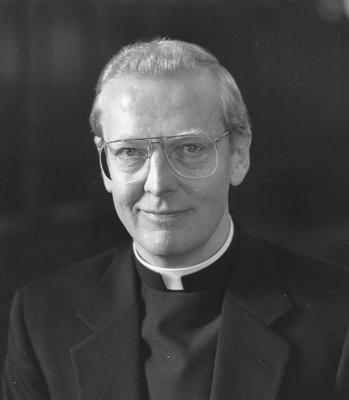President: 1989-2001
Fr. Leo O'Donovan, S.J., served as Georgetown's 47th president from 1989 to 2001. Fr. O'Donovan led Georgetown through a period of significant academic and financial growth, and his tenure also included controversies over short-lived university funding for the pro-choice club GU Choice.
Early Jesuit and academic career
Leo O’Donovan graduated from Iona Preparatory School in New York in 1952 and then attended Georgetown University where he hoped to become a psychiatrist. Two years in, he dropped his pre-med track and majored instead in Philosophy and English. O'Donovan stayed busy, writing for The Hoya and serving as editor in chief of the Georgetown College Journal, before graduating summa cum laude in 1956. After a Fulbright scholarship to study at the University of Lyon in France, O’Donovan entered the Society of Jesus in 1957. He went on to earn advanced degrees in Philosophy and Theology at Fordham University and Woodstock College before his ordination in 1966.1
From 1974 through 1989, Fr. O’Donovan taught as a professor of theology at the Weston Jesuit School of Theology in Massachusetts with a three year break spent serving as provincial assistant of formation for the Jesuit Maryland Province. On September 23, 1989, Fr. O’Donovan succeeded Fr. Timothy Healy becoming Georgetown’s forty-seventh president and the first alumnus to hold the position since Fr. Alphonsus Donlon in 1912.2
Campus master plan
One of Fr. O’Donovan’s top priorities was the development of a master plan for the main campus that focused on integrating new buildings with the architectural styling of Healy Hall and the main lawn. From 1989 until 2001, no buildings were added to campus, instead, long deferred maintenance and renovations were finally addressed. In 1997, after the Taxpayer Relief Act repealed a $150 million cap on tax-exempt bonds, the University began planning for a $170 million “Southwest Quadrangle” comprised of a 780 bed residence hall, a two-story dining hall, a new Jesuit residence, and a parking garage.3
Academic reforms
Fr. O'Donovan also oversaw the reorganization of several academic departments. In 1994, with the provost’s assistance, the School of Languages and Linguistics was placed under Georgetown College, with the Linguistics department moving under the Graduate School of Arts and Sciences. The College also received the economics, government, and history departments from the School of Foreign Service.4
Academic and financial growth
The caliber of the University’s undergraduate student body rose dramatically during Fr. O'Donovan’s tenure. In 1991, the University admitted 29% of applicants. In 2001, it admitted only 21% of applicants. Georgetown’s application process had grown more competitive than Columbia, Duke, and MIT. As the University’s prestige rose, the University’s research and development funding doubled. New institutes and centers were created, including the Georgetown Public Policy Institute in 1990 and the Center for Muslim-Christian Understanding in 1993.5
Meanwhile Fr. O’Donovan worked to build and strengthen the University’s financial position. During his eleven year term, the University’s endowment nearly tripled, increasing from $240 million to $740 million. 6In 2000, with the University’s hospital continuing to incur debt, Fr. O’Donovan brokered a deal with Medstar Health. Medstar assumed the hospital’s $80 million of debt and control of 3,000 to 4,000 medical center employees, while the University retained the medical and nursing schools and medical research programs. Fr. O’Donovan called MedStar “an ideal partner” as Medstar’s nonprofit status allowed the University to continue its religious policy of not performing abortions or sterilizations.7
GU Choice controversy
The University’s religious policy had already caused controversy earlier on in Fr. O’Donovan’s tenure. In February of 1991, Fr. Donovan allowed the Office of Student Programs to fund GU Choice, an informational group for abortion rights, arguing that the organization would contribute to “a robust exchange of ideas. ”8The blowback was immediate. William Peter Blatty (CAS '50), author of The Exorcist, wrote an open letter urging alumni to resign from fundraising positions and send their objections to Fr. O’Donovan. Manuel Miranda (SFS'82) , a Georgetown alumnus and founder of the Cardinal Newman Society, sued the University in a Canon lawsuit alleging the University’s failure to adhere to Catholic teaching. The case appeared before the Vatican in 1992 which ruled the University needed to stop funding GU Choice immediately. GU Choice was subsequently disbanded, and students organized H*yas for Choice, a non-University funded birth control and abortion rights group.9
Retirement
On March 21, 2001, Fr. O’Donovan announced his retirement. He wrote, “It is a good time for the university and for me. By June of next year I will have served 12 years. I never wanted to serve indefinitely. I ran track as a boy. I know how important in a relay it is to pass along the baton well if you want to win the race. ”10That June, Fr. O’Donovan’s tenure ended, and he was succeeded by John DeGioia. In 2003, the University named the new dining hall, the Leo J. O’Donovan Dining Hall, known familiarly as “Leo’s” by students around campus.
- 1Haggerty, Tim. “47th President: A Scholar And Administrator.” The Hoya. 21 March 2000.
- 2Emmett Curran, Robert. “A History of Georgetown University The Rise to Prominence, 1964-89.” 2010, p.273.
- 3Wong, David J. “O’Donovan to Step Down.” The Hoya. 21 March 2000.
- 4 “A History of Georgetown University The Rise to Prominence, 1964-89.” p.275.
- 5Id. at 277-79.
- 6“O’Donovan to Step Down.”
- 7Goldstein, Avram. “Georgetown U. to Sell Hospital.” The Washington Post. 18 Feb. 2000.
- 8“End of O’Donovan’s Era.” The Hoya. 24 March 2000.
- 9Redden, Molly. “Controversial Catholics…and the third coming of The Georgetown Academy.” The Georgetown Voice. 23 Oct. 2008.
- 10“O’Donovan to Step Down.”


